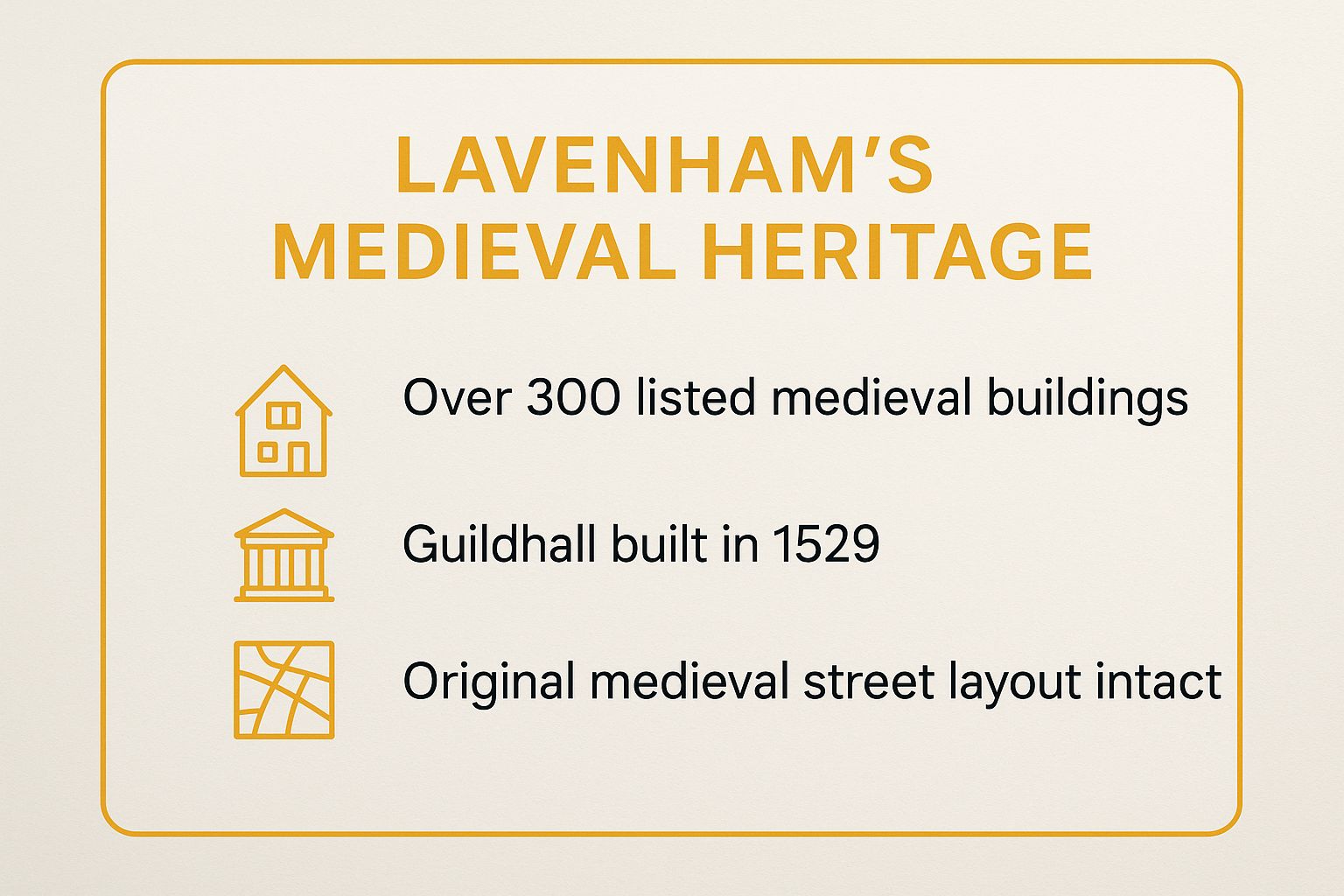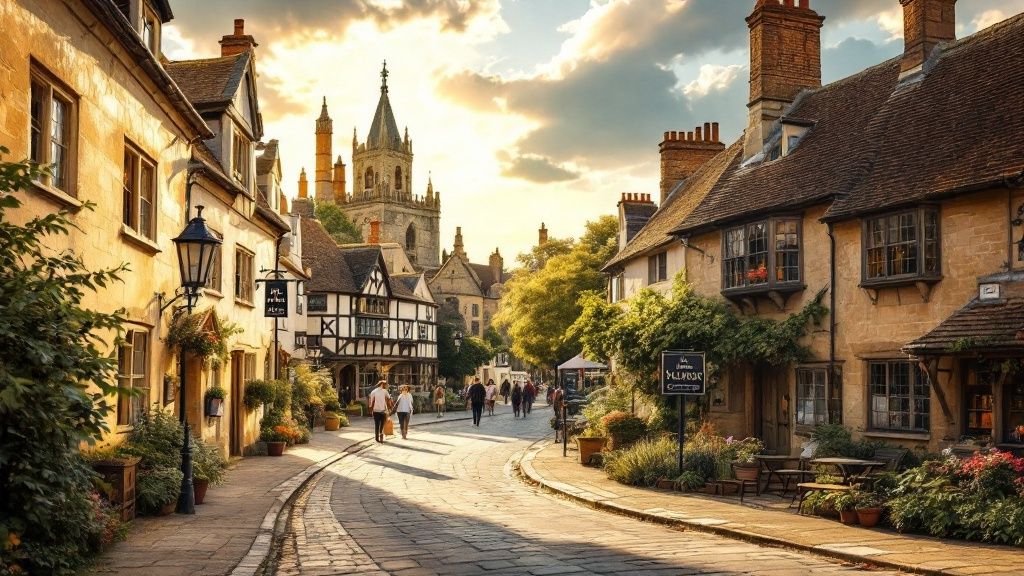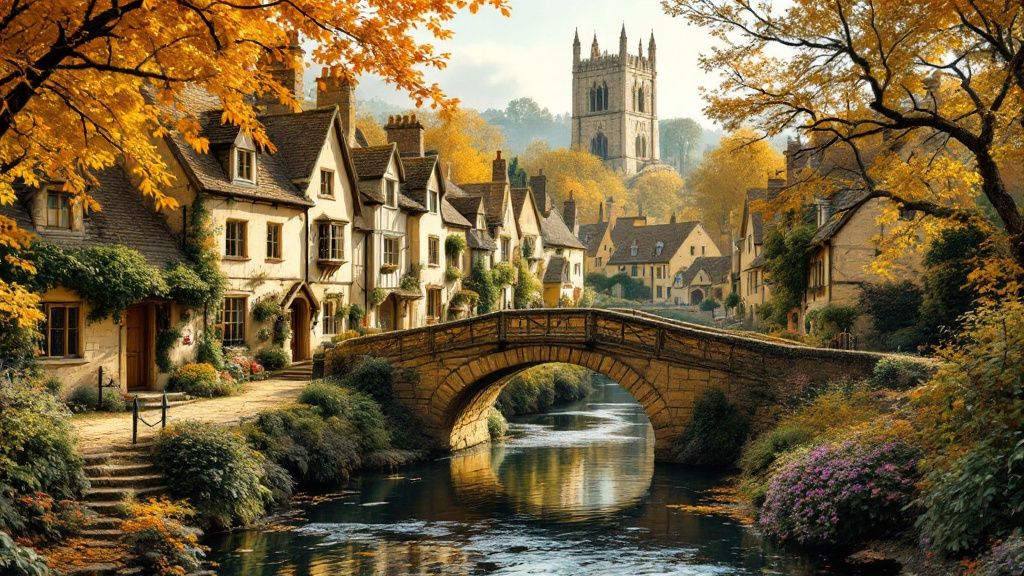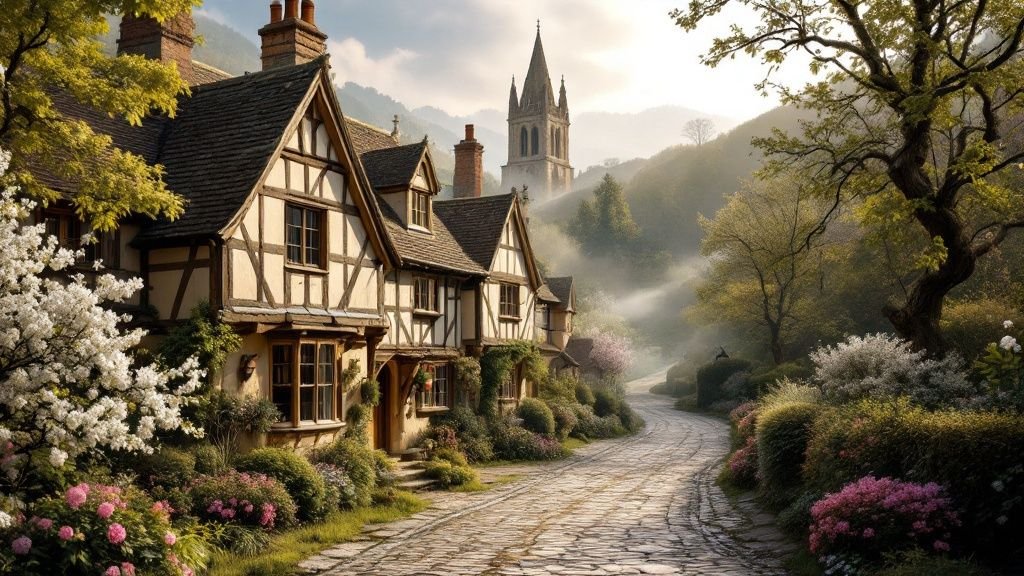Forget fleeting trends and modern bustle; England's true magic lies etched in the timber frames, cobbled lanes, and honey-hued stone of its surviving medieval settlements. These are not museum pieces but living communities where centuries of history whisper from every crooked cottage and ancient market cross. They offer a tangible connection to a past that shaped the nation, from the booming wool trade that built grand churches to the strategic conflicts that raised formidable castles.
This guide provides a roadmap to uncovering some of the most enchanting medieval villages in England, each a perfectly preserved chapter of a story stretching back a thousand years. We will journey from the wool-rich manors of Suffolk to the dramatic fortress towns guarding ancient borders, exploring the very landscapes that defined the country.
More than just a simple list, this curated selection offers a practical blueprint for your own historical adventure. Inside, you will find detailed insights into must-see sights, suggestions for scenic driving routes, and actionable travel tips to help you plan an unforgettable visit. Whether you are a dedicated history enthusiast or a cultural explorer seeking a unique self-drive tour, these timeless treasures offer a captivating glimpse into England's storied past.
1. Lavenham, Suffolk
Often called England's finest medieval village, Lavenham in Suffolk offers an extraordinary glimpse into the 15th-century wool trade boom. Its wealth funded the construction of magnificent timber-framed buildings, many of which lean at precarious angles, creating a uniquely preserved and wonderfully crooked streetscape. This architectural time capsule is no accident; the village's fortunes declined just as quickly as they rose, which paradoxically protected it from later redevelopment.
The result is one of the most complete examples of a medieval wool town in the country, boasting over 300 listed buildings. Walking through its streets feels like stepping onto a film set, which is why it has featured in productions like the Harry Potter films (as Godric's Hollow) and the BBC's Wolf Hall.
Must-See Sights and Activities
The heart of Lavenham's heritage lies in its two grandest structures: the Church of St Peter and St Paul and the Lavenham Guildhall. The church, with its soaring 141-foot tower, was a statement of the village’s immense wealth, while the Grade I listed Guildhall, now managed by the National Trust, showcases the power of the Corpus Christi guild. Beyond these landmarks, the true magic is in simply wandering through the market square and along Water Street, admiring the half-timbered houses painted in traditional Suffolk pinks, oranges, and creams.
The infographic below highlights the key statistics that underscore Lavenham's historical significance.

These figures demonstrate just how remarkably intact Lavenham's medieval character remains, from its buildings to its very layout.
Practical Travel Tips
To make the most of your visit to one of the premier medieval villages in England, consider these tips:
- Timing Your Visit: Lavenham is popular, especially on weekends. Aim for a weekday morning to experience its atmosphere with fewer crowds.
- Getting Around: The village is compact and best explored on foot. Guided walking tours are highly recommended to uncover the stories behind the crooked houses.
- Where to Stay: For a truly immersive experience, stay in a historic property like The Swan at Lavenham, a 15th-century hotel.
- Travel and Itinerary: Lavenham is easily accessible by car and can be combined with visits to other historic Suffolk wool towns like Long Melford and Kersey. For those preferring public transport, explore options for a Best of Britain by Train tour that might include nearby hubs.
2. Chipping Campden, Gloucestershire
A jewel of the Cotswolds, Chipping Campden owes its enduring beauty to the medieval wool trade, which transformed it into a prosperous market town. Its name, derived from the Old English 'cēping' for market, reflects its historic commercial importance. Built almost entirely from the region's characteristic honey-coloured limestone, the town’s elegant terraced High Street is a masterpiece of medieval urban planning, curving gently and showcasing centuries of architectural harmony.
The wealth generated by wool merchants, or "woolmen," is evident everywhere, from the grand townhouses to the imposing church. This legacy was so profound that it later inspired the Arts and Crafts movement, with artisans moving here to escape industrialisation and preserve traditional skills. Today, Chipping Campden stands as a quintessential example of Cotswold charm and one of the most perfectly preserved medieval villages in England.

Must-See Sights and Activities
The town's focal point is the magnificent Market Hall, built in 1627 by Sir Baptist Hicks to provide shelter for traders. A short walk away is the equally impressive St James' Church, a grand "wool church" funded by the town’s wealthiest merchants. Inside, you can find elaborate brass memorials dedicated to these historical figures. For a deeper understanding of local life, the Court Barn museum showcases the Arts and Crafts heritage that the town inspired.
Beyond specific landmarks, the real pleasure comes from exploring the High Street and its "courts" or alleyways. It is also the official starting point of the Cotswold Way, a 102-mile national trail, offering a direct link to the surrounding historic landscape that once produced the town's wealth.
Practical Travel Tips
To fully appreciate Chipping Campden's unique atmosphere, consider the following advice:
- Timing Your Visit: The golden-hued stone is most beautiful in the early morning or late afternoon light. Weekdays are generally quieter than weekends.
- Getting Around: The town centre is easily walkable. Look for guided tours that explain the history of the wool trade and the architectural details of the High Street.
- Where to Stay: Immerse yourself in the history by staying at a local inn like the Cotswold House Hotel & Spa, which blends historic character with modern luxury.
- Travel and Itinerary: Chipping Campden serves as an excellent base for exploring the North Cotswolds. It can be easily combined with visits to nearby Broadway and Stow-on-the-Wold. Ample parking is available, making it an ideal stop on a self-drive tour.
3. Corfe Castle Village, Dorset
Dominated by the dramatic, battle-scarred ruins of its namesake fortress, Corfe Castle Village in Dorset is a settlement shaped by centuries of conflict and industry. The village grew in the shadow of the Norman stronghold, its narrow streets and grey Purbeck stone cottages creating a scene that feels authentically medieval. Its layout, huddled beneath the castle mound, speaks directly to its defensive origins.
Owned and preserved largely by the National Trust, the village has been protected from modern development, allowing its historic character to shine through. The legacy of the local quarrying industry is evident in every building, constructed from the resilient local limestone. This unique combination of a ruined fortress and a preserved village makes it one of the most evocative medieval villages in England and a popular setting for historical adaptations.
Must-See Sights and Activities
The main attraction is, without question, the magnificent ruin of Corfe Castle itself. Managed by the National Trust, exploring its fallen walls and secret corners offers breathtaking views across the Purbeck Hills. In the village, the tiny Corfe Castle Town Trust Museum provides fascinating insights into local life and the quarrying trade.
For a memorable approach, arrive via the Swanage Railway, a heritage steam train that chugs through the picturesque countryside. Afterwards, simply wander through the village square and along West Street, admiring the ancient stone houses and stopping at a traditional pub like The Greyhound Inn, which has stood for centuries.
Practical Travel Tips
To fully appreciate this historic gem, consider the following advice:
- Timing Your Visit: The castle is a major tourist draw. Arrive early in the morning to climb the ruins before the largest crowds appear, especially during summer holidays.
- Getting Around: The village is small and easily walkable, but the castle ruins involve steep climbs. Sturdy footwear is recommended.
- Where to Stay: Stay in one of the village's historic inns or B&Bs to soak up the atmosphere after the day-trippers have left. Mortons Manor Hotel is a notable Elizabethan option.
- Travel and Itinerary: Corfe Castle is a highlight of the Jurassic Coast. It can be a key stop on a wider tour of the region, which you can explore further on a Taste of South England and Wales tour. Parking is limited in the village, so using the park-and-ride or arriving by train is often the best choice.
4. Castle Combe, Wiltshire
Frequently lauded as 'the prettiest village in England', Castle Combe in Wiltshire is a quintessential medieval village, preserved in time. Nestled in a Cotswolds valley, its character is defined by honey-coloured stone cottages, a tranquil river, and a streetscape that has remained largely unaltered for centuries. The village owes its immaculate preservation to its past as a prosperous centre for the wool industry, which faded before modern development could take hold, leaving its historic fabric intact.

This picture-perfect quality has made it a coveted filming location, appearing in productions like the original Dr. Dolittle, War Horse, and Stardust. Its timeless appeal means that a walk through its main street feels like stepping directly into a historical drama, offering one of the most immersive experiences of all the medieval villages in England.
Must-See Sights and Activities
The heart of Castle Combe is its central crossroads, where you’ll find the 14th-century Market Cross, a stone monument that once sheltered market traders, and the adjacent St. Andrew's Church. The church is notable for housing a faceless clock, one of the oldest working clocks in the country. The most iconic view, however, is from the bridge over the By Brook river, looking back towards the village’s weaver cottages.
Simply strolling along The Street and West Street is the main activity. There are no grand attractions beyond the architecture itself; the beauty is in the atmosphere and the remarkable state of preservation. The quiet lanes and meticulously maintained cottages create an overwhelming sense of peace and history.
Practical Travel Tips
To best enjoy your visit to this exceptionally popular village, keep the following advice in mind:
- Timing Your Visit: The village is very small and can become extremely crowded. Arrive very early in the morning (before 9 am) or late in the afternoon to avoid the main tourist rush and capture the best photographs.
- Parking and Access: There is a dedicated car park on the hill above the village. Parking within the village itself is extremely limited and restricted, so use the official car park and enjoy the short, scenic walk down.
- Respect for Residents: Remember that Castle Combe is a living village, not a theme park. Be considerate by not blocking driveways, keeping noise levels down, and respecting the privacy of residents.
- Travel and Itinerary: Castle Combe is an ideal stop on a wider tour of the Cotswolds. It fits perfectly into a driving holiday, and you can explore more about incorporating it into a planned route with a Taste of England self-drive tour that covers this stunning region.
5. Clovelly, Devon
Clinging to a 400-foot cliff face in North Devon, Clovelly is a breathtakingly unique medieval village, seemingly untouched by the modern world. Its charm lies in a steep, cobbled high street that tumbles down to a tiny, ancient harbour on the Bristol Channel. The village is famously privately owned and has been managed by the same family since 1738, a stewardship that has preserved its traditional character and car-free environment.
This remarkable preservation effort means that goods are still transported by sledge, and the quiet, traffic-free lanes offer an authentic journey back in time. The village’s maritime history is palpable, from the fisherman's cottages draped in flowers to the salty air of the harbour. Its timeless atmosphere has long inspired artists and writers, most notably Charles Kingsley, who lived here and featured it in his novel Westward Ho!.
Must-See Sights and Activities
The main activity in Clovelly is the unforgettable walk down 'Up-a-long' and 'Down-a-long' street, soaking in the views and exploring its quaint side alleys. At the bottom, you’ll find the historic Red Lion Harbour Bar, perfect for a rest while watching boats in the 14th-century harbour. Don’t miss the Kingsley Museum to learn about the village’s most famous resident, or the Fisherman's Cottage to see how a fishing family would have lived in the 1930s.
A Land Rover service is available to take visitors back up the hill for a small fee, but the walk down is an essential part of the Clovelly experience. The combination of stunning sea views, historic architecture, and living heritage makes it one of the most distinctive medieval villages in England.
Practical Travel Tips
To make the most of your journey down Clovelly's cobbled streets, consider these recommendations:
- Footwear is Key: Sturdy, comfortable shoes with good grip are essential for navigating the steep, cobbled terrain safely.
- Getting Around: The village is pedestrian-only. Day visitors park at the top and walk down. Residents and overnight guests use sledges to transport luggage.
- Best Viewing Times: The harbour is at its most picturesque at high tide. Check the tide times before your visit to see it in its full glory.
- Where to Stay: For a truly immersive experience, book a room at the Red Lion Hotel right on the harbour, but be sure to book well in advance as it's very popular.
6. Kersey, Suffolk
Nestled in the heart of the Suffolk countryside, Kersey is the quintessential English medieval village, seemingly frozen in time. Its fame derives from its single, picturesque street that slopes down to a ford, known locally as 'The Splash', before rising steeply on the other side. This unique water feature, combined with rows of pastel-coloured, timber-framed houses, creates a scene of almost storybook perfection.
The village's prosperity, like its neighbours, was built on the medieval wool trade. It gave its name to the coarse, twilled woollen cloth, 'Kersey cloth', which was a staple export across Europe in the 14th and 15th centuries. The wealth generated from this trade is evident in the quality of the surviving buildings, which have remained remarkably unchanged for centuries, making Kersey one of the most photogenic medieval villages in England.
Must-See Sights and Activities
The defining feature of Kersey is The Splash, a ford that crosses the main street where the River Brett runs through. It's the central point around which the village is organised and provides countless photographic opportunities. At the top of the hill stands the imposing St Mary's Church, a Grade I listed building whose origins stretch back to the 12th century. The climb to the church is rewarded with a spectacular panoramic view over the village and the surrounding rolling hills.
Beyond these landmarks, the pleasure of Kersey lies in its atmosphere. A gentle stroll down the main street, a stop at the classic village pub, and simply absorbing the peaceful, historic surroundings is an activity in itself. Many of the beautiful houses are private residences, so admire them respectfully from the street.
Practical Travel Tips
To fully enjoy your visit to this beautifully preserved medieval village, keep these pointers in mind:
- Best Viewing Point: For the classic postcard view of the village, ascend the hill towards St Mary's Church. The vantage point from the churchyard is unparalleled.
- Navigating 'The Splash': The ford is shallow enough for most cars to drive through, but there is a footbridge for pedestrians. If visiting after heavy rain, be prepared with wellington boots for exploring.
- Parking: Parking in the village is extremely limited. Be sure to use designated areas and park considerately, as the narrow street can become congested.
- Respectful Visiting: Kersey is a living community, not a museum. Be mindful of private property and gardens when taking photos and exploring.
7. Conwy, North Wales (English Medieval Heritage)
While geographically in Wales, Conwy is a monumental testament to English medieval ambition and represents the pinnacle of 13th-century military engineering. Built by King Edward I between 1283 and 1287 as one of his 'iron ring' of castles to secure his conquest of Wales, the town and its fortress were designed as a single, cohesive masterpiece by Master James of St George. This integrated approach created one of Europe’s most magnificent and complete examples of a late medieval fortified town.
The town’s immense stone walls, punctuated by 21 towers and three gateways, stretch for nearly a mile and completely enclose the original settlement. This remarkable state of preservation has earned Conwy its prestigious UNESCO World Heritage status, offering an unparalleled insight into medieval urban planning and defence. Its dramatic setting on the estuary makes it not just historically significant but also breathtakingly scenic, cementing its place as an essential visit for anyone exploring medieval heritage in the British Isles.
Must-See Sights and Activities
The undisputed centrepiece is Conwy Castle, a brooding, formidable fortress whose eight great towers dominate the skyline. Exploring its battlements offers stunning views over the town and the Snowdonia mountains beyond. Just as impressive is the opportunity to walk the Town Walls, which provide a complete circuit and a unique perspective on the medieval street plan. Within the walls, discover the Smallest House in Great Britain and Plas Mawr, an exquisitely preserved Elizabethan townhouse that shows how the town flourished in the centuries that followed its medieval founding.
Practical Travel Tips
To fully appreciate this formidable example of medieval history, which has more in common with fortified English towns of the era than many others, consider these suggestions:
- Timing Your Visit: The castle and walls are major attractions. Arrive early in the morning to avoid the largest crowds, particularly during the summer holidays.
- Getting Around: The walled town is a joy to explore on foot. Wear comfortable shoes, as the walk along the town walls involves some steps and uneven surfaces.
- Where to Stay: Stay within the town walls for a truly atmospheric experience. Numerous guesthouses and inns are housed in historic buildings.
- Travel and Itinerary: Conwy is a highlight of any trip to the region. To plan a broader journey, you can discover more about exploring the historic wonders of Wales and integrate Conwy into a larger itinerary.
Medieval Village Comparison: Top 7 English Sites
| Location | Implementation Complexity | Resource Requirements | Expected Outcomes | Ideal Use Cases | Key Advantages |
|---|---|---|---|---|---|
| Lavenham, Suffolk | Moderate (preservation of timber framing and medieval streets) | High (maintenance of 300+ listed buildings) | Authentic medieval village experience | Heritage tourism, medieval architecture study | Exceptional preservation, strong community, film location |
| Chipping Campden, Gloucestershire | Moderate (maintaining limestone buildings and market hall) | High (UNESCO standards, infrastructure upkeep) | Picturesque Cotswold market town | Heritage tourism, arts and crafts inspiration | UNESCO status, architectural unity, hiking access |
| Corfe Castle Village, Dorset | Complex (castle ruins preservation, terrain challenges) | High (castle upkeep, National Trust involvement) | Historic fortress village experience | Castle tourism, military history study | Dramatic setting, National Trust protection, heritage railway |
| Castle Combe, Wiltshire | Moderate (stone cottage and bridge preservation) | Moderate (conservation and parking limitations) | Picture-perfect medieval village | Film location, photography, tourism | Well-preserved, photogenic, peaceful rural environment |
| Clovelly, Devon | High (steep terrain, car-free, private management) | Moderate to High (private ownership and maintenance) | Unique medieval fishing village | Sustainable heritage tourism, maritime history | Unique transport methods, traffic-free, authentic culture |
| Kersey, Suffolk | Moderate (timber framing and water splash features) | Moderate (flood and street maintenance) | Classic wool village charm | Medieval village studies, photography | Iconic water splash, peaceful atmosphere, active community |
| Conwy, North Wales | High (fortification and castle upkeep, wall circuit) | High (UNESCO, fortification maintenance) | Premier medieval military town | Military architecture study, heritage tourism | Complete walls, UNESCO site, strong tourism infrastructure |
Planning Your Own Medieval Adventure
Embarking on a journey through England’s medieval villages is more than a simple holiday; it’s an immersive step back in time. As we've explored, from the impossibly crooked timber-framed houses of Lavenham to the formidable stone fortress overlooking Conwy, each destination offers a unique and tangible connection to a past that has profoundly shaped the nation. You’ve seen how the Cotswold stone of Chipping Campden tells tales of the wool trade’s riches, while the dramatic ruins of Corfe Castle whisper of civil war and royal intrigue. These are not just collections of old buildings; they are living museums, each with its own distinct character, history, and charm.
The true magic of visiting these historic sites lies in understanding their context. A walk through Castle Combe becomes more meaningful when you know it was a centre for the weaving industry, and the steep, cobbled descent into Clovelly feels more adventurous when you appreciate its centuries-old reliance on donkeys. Your adventure is about weaving these individual stories into a grander narrative of medieval England, understanding the resilience, innovation, and community spirit that allowed these settlements to flourish.
Turning Inspiration into Itinerary
To truly make the most of your trip, thoughtful planning is essential. Consider which aspects of history most captivate you. Are you drawn to the legacy of powerful castles, the quiet devotion of ancient parish churches, or the bustling energy of historic market towns?
Here are some practical steps to help you craft your perfect historical tour:
- Theme Your Journey: You could centre your trip around a specific region, like the Cotswolds (Chipping Campden, Castle Combe) or Suffolk (Lavenham, Kersey), to minimise travel time and deepen your understanding of the local character. Alternatively, a thematic tour focusing on the wool trade or Norman castles could create a compelling route across the country.
- Logistical Preparedness: Before you set off, ensure all practicalities are in order. This includes booking accommodations well in advance, especially during peak seasons, and arranging reliable transport. For international visitors, an important part of this preparation is researching essential services. Taking a moment to arrange comprehensive United Kingdom travel health insurance can provide crucial peace of mind, letting you focus entirely on the historical wonders around you.
- Beyond the Highlights: While the must-see sights are unmissable, the most memorable moments often happen when you venture off the beaten path. Allocate time to simply wander without an agenda, discover a hidden alleyway, or enjoy a quiet pint in a centuries-old pub. It’s in these unscripted moments that the soul of these medieval villages in England truly reveals itself.
Ultimately, a tour of these timeless landscapes is an investment in wonder. It’s an opportunity to walk in the footsteps of knights, merchants, and artisans, and to see firsthand how their legacy endures in the stone, timber, and very soil of England. So, take these ideas, chart your course, and prepare for an adventure that will enrich your understanding of history and leave you with memories that will last a lifetime.
Ready to explore these historical landscapes without the stress of planning every detail? BTOURS specialises in crafting bespoke self-drive itineraries that connect England's most enchanting medieval villages. Let us design your perfect journey, complete with hand-picked accommodations and expert local insights, so you can focus on the discovery. Start planning your unforgettable journey back in time with BTOURS today.



